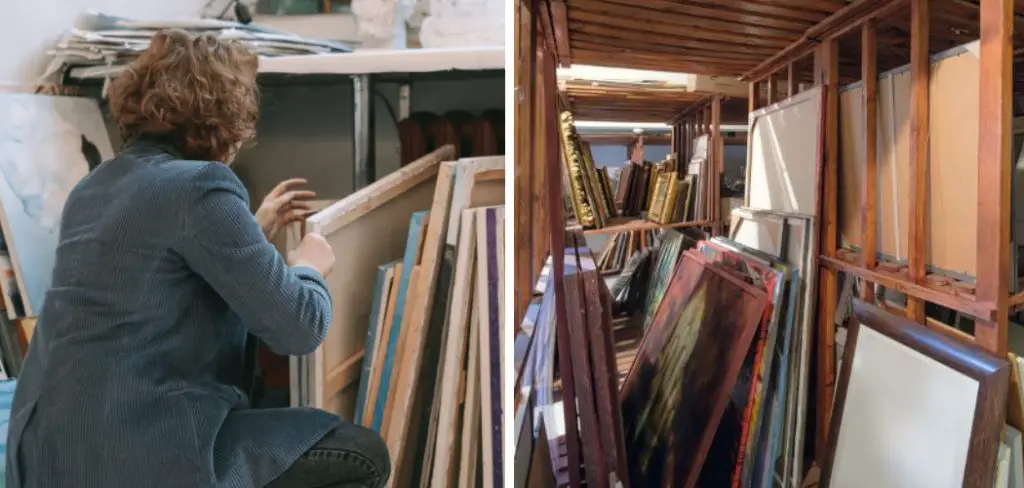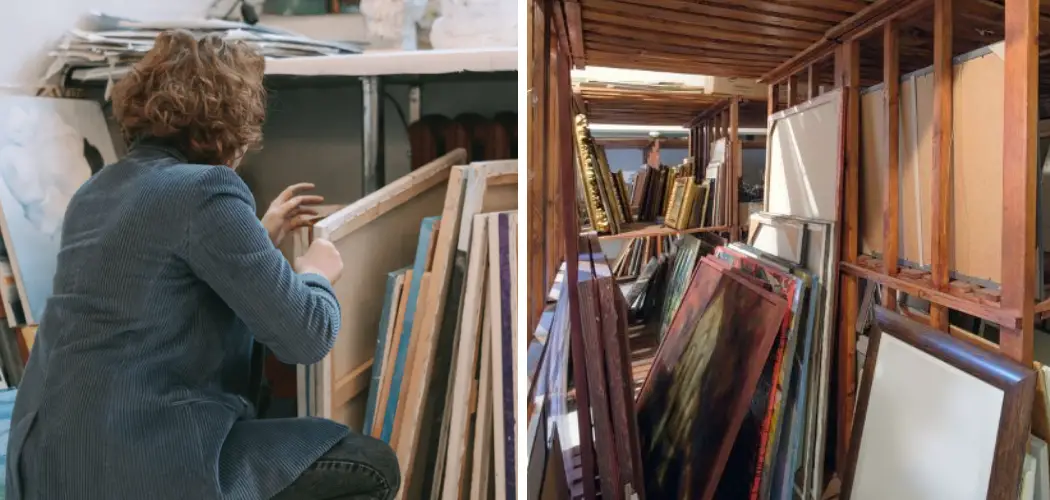Storing paintings properly is essential to maintain their value and preserve them for future generations. As a homeowner, you might have a precious painting collection that you want to display or store in the best possible way. Whether it’s an expensive piece of art or a family heirloom, storing your paintings at home requires attention and care.

The main advantage of storing paintings at home is that it allows you to have easy access to your artwork whenever you want. You can enjoy them in the comfort of your own home, without having to travel to a gallery or museum. This also gives you the opportunity to regularly rotate and change the display of your paintings, keeping your living space fresh and interesting. Read this blog post to learn how to store paintings at home.
Step-by-step Instructions for How to Store Paintings at Home
Step 1: Inspect your painting
Before you begin, it’s important to inspect your paintings for any damage or signs of deterioration. Look for things like scratches, cracks, and discoloration. If you find any issues, consult a professional art restorer before storing your painting.
Step 2: Clean the frame
Using a soft cloth or brush, gently clean the frame of your painting. This will help remove any dust or debris that could potentially damage your artwork. When choosing a spot to store your painting, make sure it is not exposed to direct sunlight. Sunlight can cause color fading and damage the quality of your painting over time.
Step 3: Choose a cool, dry location

The ideal spot to store paintings is in a cool, dry location. Avoid places like basements or attics that are prone to temperature and humidity fluctuations. When wrapping your painting for storage, make sure to use acid-free materials. Acidic materials can damage the surface of your painting over time.
Step 4: Wrap in bubble wrap
After cleaning and inspecting your painting, wrap it in acid-free paper or bubble wrap. This will provide a protective barrier against dust and potential damage. If possible, store your paintings upright rather than stacked on top of each other. This will prevent any pressure or weight from damaging the artwork.
Step 5: Rotate periodically
To prevent damage from sunlight and humidity, it’s important to rotate your paintings periodically. This will also allow you to check for any signs of damage or deterioration. If you have valuable or delicate paintings, it may be worth investing in a climate-controlled storage unit. These units maintain a consistent temperature and humidity level, providing the best environment for storing artwork.
Step 6: Check regularly
Even when stored properly, it’s important to check your paintings regularly for any signs of damage. This will allow you to catch any issues early on and prevent further damage.
By following these step-by-step instructions, you can ensure that your paintings are stored safely at home and preserved for years to come. Remember to always handle your artwork with care and consult a professional if you have any concerns about its condition.
Safety Tips for How to Store Paintings at Home

- Wear gloves when handling your paintings to prevent oils from your hands damaging the surface.
- Avoid using plastic or cling wrap as it can trap moisture and cause damage to the painting.
- If storing multiple paintings together, make sure they are properly separated to avoid any potential scratches or damage.
- Keep a record of where and how you stored each painting for future reference.
- Avoid storing paintings near sources of heat or moisture, such as radiators or vents.
- If you live in a humid climate, consider using dehumidifiers in the storage area to prevent mold growth.
- When moving your paintings, always transport them upright and secure to avoid any potential damage.
Remember to always handle your artwork with care and take necessary precautions to protect it from any potential damage while in storage. With these safety tips, you can ensure that your paintings will be preserved for generations to come as a cherished part of your home.
How Can You Prevent Pests and Insects From Damaging Your Stored Paintings?
While storing your paintings at home, it’s important to also protect them from potential damage caused by pests and insects. Here are a few tips on how you can prevent these unwanted visitors from harming your artwork:
1. Clean the Storage Area
Before storing your paintings, make sure to clean the storage area thoroughly. This includes vacuuming and dusting to remove any potential food sources for pests.
2. Use Insect Repellents
Consider using natural insect repellents such as cedar wood, lavender sachets, or peppermint oil to deter pests from entering the storage area.
3. Inspect Regularly

Regularly check your paintings for any signs of pest infestation, such as small holes, droppings, or webbing.
4. Avoid Storing Food Nearby
Keep all food and drinks away from the storage area to avoid attracting pests.
5. Keep the Storage Area Dry
Pests are attracted to moist areas, so make sure your storage space is kept dry to prevent any infestations.
6. Use Sealed Containers
If possible, store your paintings in sealed containers or bins to prevent pests from accessing them.
7. Seek Professional Help
If you suspect a pest infestation, seek professional help to safely remove the pests and protect your artwork from any further damage.
By following these tips, you can ensure that your stored paintings are protected from potential damage caused by pests and insects. Remember to regularly check for any signs of infestation and take necessary measures to prevent them from harming your valuable artwork. Overall, proper storage techniques and precautions are key to preserving your paintings for years to come.
Are There Any Potential Risks or Dangers to Be Aware of When Storing Paintings at Home?

Paintings are not only valuable in terms of monetary worth, but they also hold sentimental value for many people. As such, it is important to take proper care when storing them at home to ensure their longevity and preservation. While there are many benefits to storing paintings at home, there are also potential risks and dangers that need to be considered.
One of the main risks when storing paintings at home is exposure to environmental factors such as temperature, humidity and light. Extreme temperatures can damage the paint and canvas, causing cracking or warping. Similarly, high levels of humidity can cause mold growth on the painting’s surface. Excessive exposure to light, especially direct sunlight, can also lead to fading or discoloration of the painting.
Another risk to consider is the potential for physical damage. Paintings are delicate and can easily be damaged if not stored properly. This includes risks such as accidental knocks, falls or tears in the canvas. It is important to handle paintings with care when moving them and to store them in a secure location where they will not be at risk of being bumped or knocked over.
What Are Some Common Mistakes to Avoid When Storing Paintings at Home?
One of the most common mistakes when storing paintings at home is improper handling and storage techniques. This includes using incorrect materials or methods, which can lead to damage or deterioration of the painting over time. It is important to use acid-free materials when wrapping and packaging paintings, as acidic materials can cause discoloration and degradation of the artwork.

Another mistake to avoid is overcrowding and stacking paintings on top of each other. This can result in pressure being placed on the paintings, causing damage to the canvas or frame. It is important to provide enough space for each painting to prevent any potential physical damage.
In addition, it is crucial to avoid storing paintings in areas that are prone to high levels of moisture, such as basements or attics. These areas are more susceptible to temperature and humidity fluctuations, which can be harmful to paintings. It is recommended to store paintings in a climate-controlled area with consistent temperature and humidity levels.
Conclusion
In conclusion, storing paintings at home requires careful consideration and attention to detail. Whether you are a professional artist or simply someone who enjoys collecting art, it is important to properly store your paintings in order to preserve their value and beauty.
One of the most important factors when storing your paintings at home is to take into account the environment they will be stored in. This includes controlling the temperature and humidity levels to prevent damage such as warping or mold growth.
It is recommended to keep the temperature between 65-75 degrees Fahrenheit and humidity levels between 40-50%. I hope this article has been beneficial for learning how to store paintings at home. Make Sure the precautionary measures are followed chronologically.

